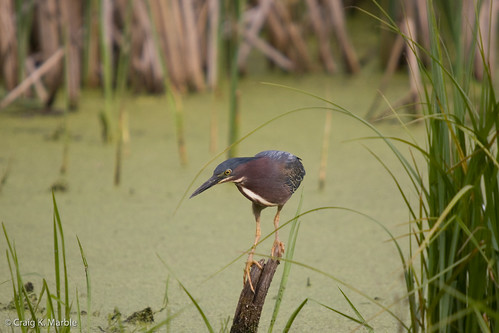I was asked by
Ivar's Birds to post a review of my new camera equipment. So here is what I think so far.
I've taken about 300 photos so far with my new
Canon 40D and
Canon 100-400L lens. The majority of the shots have been hand held with an ISO range of 200-400. I haven't shot at higher ISO's yet, so I'll need to report on that at a later date. So given that context here is my review of the body and lens.
Canon 40D:
Usability - I have been shooting a Canon 20D for the past few years and the layout of controls on the 40D is very similar so the transition to the new camera body was quite natural. The back of the camera has a much larger (and brighter) LCD that is actually usable in terms of quick photo reviews versus the LCD on the 20D which was quite small and was useful only for histogram checks in my opinion. The 40D body is a bit larger and heavier but still feels comfortable in my hands. The 40D has a new feature of Auto ISO which is a nice feature, but when shooting in Manual mode it automatically sets it to ISO 400. That's fine, but I wish I had the ability to set which ISO it defaulted to when in Manual mode. It's not a big deal, but it would be nice to have that kind of control.
Image Quality - Shooting most of my shots at lower ISO settings I haven't seen any noise in my photos. I did a lot of image quality comparisons before buying this camera and I don't expect to see much noise until around ISO 1600, but again, I haven't done this yet, so we'll see if that pans out. Another item worth mentioning here is that this camera has Sensor Cleaning at startup/shutdown time. So far this has not affected me, but over the long run it should help with dust on the sensor (only time will tell though).
Canon 100-400mm:
Usability - The size of the lens is quite manageable in my opinion. Even when fully extended to 400mm the weight seems to be evenly distributed with the 40D. The lens is a push/pull zoom and I was a bit apprehensive about getting used to that, but so far I haven't found it to be a problem. The one issue I do have is with the positioning of the manual focus ring. On this lens, the manual focus ring is usable even when Auto Focus is turned on. The issue I have is that the focus ring sits just behind the main grip for the push/pull zoom and I have occasionally bumped the focus ring while framing my shot via the zoom. I think this falls more under the category of "getting used to it" than a poor design, but it is something I'll need to figure out. (I also have smaller hands which could also be a factor.)
Image Quality - I have been extremely happy with the sharpness of this lens. All of the pictures I have posted since getting my new equipment have been hand held shots, and when looking at the full resolution RAW files the level of sharpness is quite good. Compared to what I was used to with the Sigma 50-500 it is significantly better. The part I am most impressed with though is the lack of
Chromatic Aberration (CA). If you look at the shots below of the Great-horned Owl where you have dark branches against a basically white sky you would normally see CA on the edges of the branches with a lesser quality lens. I see none on any of the photos that I took under these conditions and that is remarkable in my opinion. The Sigma 50-500 under these conditions would show (significant) CA.
Overall Opinion:
I am incredibly happy with this lens/body combination in terms of usability and image quality. I've only taken a small amount of photos with the camera so far, but the percentage of quality shots is much higher than what I was getting with my previous equipment. For those of you that know me, I don't normally make recommendations when it comes to items like these, but I would feel pretty confident in recommending either piece of equipment.
I hope that this all makes sense and if you have questions about any of this, please let me know.
Good birding (photography) to all!
Craig
PS The Sigma 50-500 has been a great lens for me over the last few years and has given a great deal of good service.















